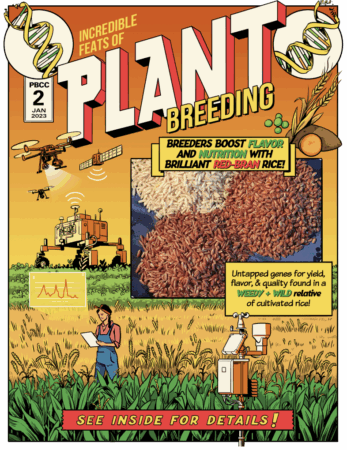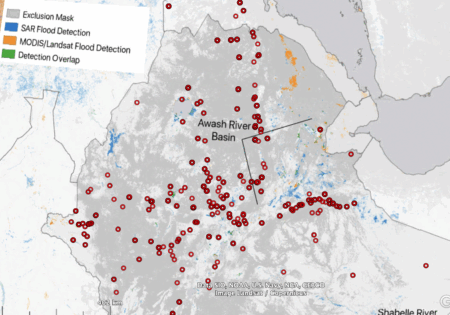 The latest GRIN-U newsletter points to a really nice series of infographics from the USDA’s Plant Breeding Coordinating Committee that I didn’t know about. But there’s a whole lot more. Explore away.
The latest GRIN-U newsletter points to a really nice series of infographics from the USDA’s Plant Breeding Coordinating Committee that I didn’t know about. But there’s a whole lot more. Explore away.
Before the flood
So, three years back, I posted about the floods in Pakistan, and how genebanks could potentially help farmers recover any crop diversity they lost because of them. But wouldn’t it be even better if the danger of flooding could be predicted? That way crop diversity from at-risk areas could be collected, if not already in genebanks, and multiplied up ready to be distributed should disaster strike.
Well, a recent paper does just that, using AI, no less: “We use our model predictions to identify historically flood-prone areas in Ethiopia and demonstrate real-time disaster response capabilities during the May 2024 floods in Kenya.”
I’ve managed to geo-reference a screen grab of the Ethiopia map provided in the paper using MapWarper, import it into Google Earth, and add the locations of sorghum landraces as reported in Genesys. Here’s what I got.
Unlike in the Pakistan example, there’s not much in the way of genebank accessions from areas of Ethiopia that are particularly at risk from flooding, it seems from this. However, Genesys does not (yet) include geographic provenance data for sorghum from the national genebank of Ethiopia. The 4000-odd sorghum accession from Ethiopia currently in Genesys are conserved at ICRISAT.
Brainfood: Defining domestication, Pig domestication, Archaeological orphan crops, Levant Neolithic causes, Altiplano agricultural origins, Irish cattle, Islamic Green Revolution, Ancient fish DNA, Ancient Chinese rice
- A universally applicable definition for domestication. Domestication is just evolution in anthropogenic environments.
- Early evidence for pig domestication (8,000 cal. BP) in the Lower Yangtze, South China. Evolution in anthropogenic environments can follow different pathways.
- Orphan crops of archaeology-based crop history research. Some crops are also neglected by archaeologists. Maybe because they weren’t domesticated enough?
- Catastrophic fires and soil degradation: possible association with the Neolithic revolution in the southern Levant. Domestication was caused by lightning.
- Altiplano agricultural origins was a process of economic resilience, not hardship: Isotope chemistry, zooarchaeology, and archaeobotany in the Titicaca Basin, 5.5-3.0 ka. Farming was not caused by anything so traumatic as lightning on the Altiplano.
- Changing human-cattle relationships in Ireland: a 6000-year isotopic perspective. Open land management of cattle in the Iron Age led to their central position in Irish culture. Maybe lightning was involved in clearing the land?
- Re-thinking the ‘Green Revolution’ in the Mediterranean world. The impact of the Islamic Green Revolution was down to more than just new crops and irrigation. Bit like the modern Green Revolution then?
- Roman Atlantic garum: DNA confirms sardine use and population continuity in north-western Iberia. You can characterize and compare old fish remains based on the DNA that survived fermentation at the bottom of ancient salting vats.
- Exploration of crop germplasm resources knowledge mining in Chinese ancient books: a route toward sustainable agriculture. You can characterize and compare old rice varieties based on the descriptions that survived in ancient chronicles. Maybe pig varieties too?
Who feeds the world anyway?
For decades, the mantra of “feeding the world” has dominated discussions about agricultural development and food security. The logic sounds straightforward: more food production equals less hunger.
Michael Grunwald, in his new book Feeding the World But Killing the Planet, acknowledges agriculture’s environmental toll but insists that industrial farming—backed by technological fixes—is necessary to meet humanity’s caloric demands. He doesn’t challenge the system, he documents ways to optimize it.
But others argue this is a dangerous simplification. In The Enduring Fantasy of “Feeding the World”, which starts by quoting Grunwald, authors from the Agroecology Research-Action Collective contend that hunger isn’t primarily about food shortages — it’s about poverty, inequality, and political exclusion. The production-first mantra, they argue, legitimizes destructive farming practices that serve elites while leaving the root causes of hunger untouched. They come up with a slogan of their own for the alternative: “a world that feeds itself.”
One camp calls for systemic change — agroecology, local food sovereignty, and policies that tackle inequality. The other seeks to refine the existing model with new technologies that deliver efficiency gains. Both see the ecological risks, but diverge on whether to reinvent or retrofit the system. 1
It occurs to me that I could fall back on my own usual ploy of observing with a self-satisfied smirk that, either way, crop diversity will be needed. But maybe it’s time to do away with catchphrases altogether. It’s more complicated, and more important, than that.
Brainfood: Agroforestry, Afro-descendant conservation, Opportunity crops, Off-farm income, Phureja conservation, European taro, Argania products, Honeybee intensification, Mycorrhizal hotspots
- Effects of tree cover and crop diversity on biodiversity and food security in tropical agricultural landscapes. In tropical agricultural landscapes, modest tree cover in diverse cropping systems supports higher biodiversity and higher crop yields, demonstrating that agroforestry can deliver win-win synergy between conservation and food production.
- Afro-descendant lands in South America contribute to biodiversity conservation and climate change mitigation. I guess biodiverse landscapes managed according to traditional knowledge deliver superior environmental outcomes not just in farms with trees but also in forested territories under community management.
- Science for Africa’s future food security: reimagining the histories and futures of underutilised crops. Reviving indigenous, underutilised crops in sub-Saharan Africa by restoring their historical and cultural significance can enhance nutritional diversity, climate resilience and food security, paralleling the evidence above that culturally rooted, biodiversity-rich systems are good for both the environment and communities.
- Off-farm income and dietary diversity in subsistence farming in Burundi. Across rural and urban settings, from farms to forests to cities, culture-informed, biodiversity-rich food systems offer interlocking benefits: ecological resilience, climate mitigation, improved nutrition, and community empowerment. Or am I stretching a point here?
- Cultivar loss and conservation of genetic resources of the phureja potato (Solanum phureja L., Phureja Group) in Peru. Traditional Andean farming communities are witnessing the disappearance of this culturally significant diploid potato group, which has rich genetic diversity and interesting adaptations, highlighting an urgent need for in situ conservation to preserve it. Oh wow, look, locally rooted, biodiversity-rich farming systems, anchored in cultural heritage, are key to sustaining ecosystem services, safeguarding genetic diversity, and building climate-resilient, equitable food futures. Again.
- Taro (Colocasia esculenta) in Europe: a journey through fields, botanical gardens, ditches and city markets. This culturally important root crop was introduced in Europe in antiquity and now survives in fields, markets, and even city waterways as both ornament and food, but despite its genetic and cultural richness, it remains under-researched and requires both ex situ and in situ conservation to safeguard its long-term use. So yep, even this one says that conserving crop diversity through culturally embedded, multi-dimensional stewardship is essential for strengthening food security and preserving heritage in a changing climate.
- Innovation of argan (Argania spinosa (L.) Skeels) products and byproducts for sustainable development of rural communities in Morocco. A systematic literature review. Innovative uses of argan tree products and by-products in Morocco, from bioplastics and biochar to livestock feed and natural repellents, offer promising pathways for conservation, cultural preservation, and rural economic development, provided local communities are actively engaged in participatory management. Where have I heard that before?
- Negative ecological impacts of honeybees begin at densities below recommended levels for crop pollination. Too many honeybee hives can reduce wild bee abundance, species richness, and fruit yield on farms, even when wildflower strips are present, suggesting that ecological balance is disrupted when managed pollinators outcompete native species. Which can probably be cleverly connected with all of the above with a little more time than I have at the moment.
- Global hotspots of mycorrhizal fungal richness are poorly protected. What can I tell you, we need in situ conservation for mycorrhiza too. And machine learning can help us figure out where best to do it. For all of the above, and more, naturally.
